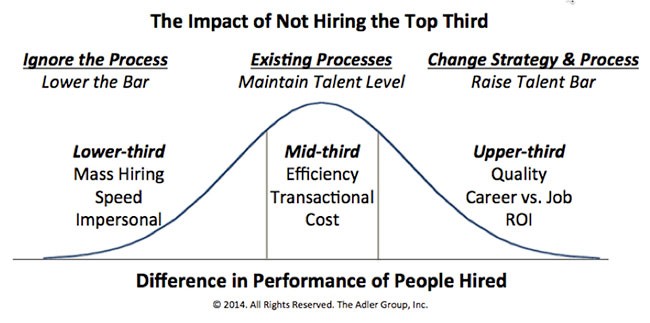Top 10 Dumb Things Companies Do to Sabotage Hiring the Best
Every company and every manager wants to hire a great person: someone who can raise the talent level of the team, someone who can handle the toughest projects with limited direction, and someone who has the potential to back up the manager. However, companies and managers go out of their way to prevent these types of great hires from happening.
The chart below is a representation of a company’s current workforce broken into thirds from worst to best. Companies can do a better job of aligning their recruiting and hiring resources based on how each of these groups are formed, but few do. For example, take this quick poll to find out how the top-third is typically hired. As you’ll see it’s largely through internal promotions, networking, university hiring, and fully engaged and discriminating managers who insist on hiring the best.
However, today most companies are not focusing on what’s driving their best hires. Instead, they concentrate on efficiency, cost control and the avoidance of mistakes, and thus continue to hire clones of the people they have always hired – those in the middle-third. As a result, these companies screen out high-potential candidates, diversity candidates, returning military veterans, anyone who looks or thinks differently, and just about everyone who wants a better job, not an identical job. These are all of the people who eventually make their way into the upper-third.
Think about your hiring process – do you optimize for hiring in the upper-third or are you content with the status quo? Here are the top 10 mistakes that companies stuck in the middle third make:
1. Filter candidates on skills and experience.
The best people do more with less, they get promoted faster, they work better with multi-functional teams and they handle bigger projects sooner. Unfortunately these attributes do not always translate into “required skills” and are filtered out for the sake of efficiency during the hiring process.
2. Target the wrong talent pool with the wrong marketing messages.
There are few top-third people who are actively looking on job boards and are willing to consider what appears on the surface to be a lateral transfer. Most find their jobs through some type of referral or networking process. Stop wasting your time by trying to attract top talent in forums they don't go to – start working to get more referrals.
3. Use narrow compensation ranges that prevent the best from even being considered.
The best people tend to make money more than most and while they might consider a different compensation mix, the discussion rarely gets that far. Being stuck with a pre-determined and non-flexible salary range won’t get you the best talent – be ready to push your limits in order to even start a conversation with a great candidate.
4. Insist on generic competencies.
Using competency models is another word for cloning. It’s a surefire way to prevent diversity of thought and diversity of action.
5. Ignore first impression bias and the “halo effect.”
Most interviewers go out of their way to prove that people they like are fully competent and that those they don’t, aren’t. A good portion of people hired this way wind up becoming the bottom-third.
6. Unknowingly permit “a hire in our own image” mentality to exist.
We all like to hire people just like us. This is another cloning technique that will limit the breadth and depth of your company. Branch out and find people who bring in fresh perspective and talents.
7. Advocate the behavioral interview.
This should be called the cloning interview. Why not find people who have better results using different behaviors?
8. Use gladiator voting.
Adding up a bunch of yes/no votes is a surefire way to hire the consensus candidate, not necessarily the best candidate.
9. Find safety in a no vote.
Hiring high potential candidates with a different mix of experiences and skills is too risky for most managers. It’s easier to say no than yes to someone who’s a bit of a misfit or who needs some seasoning, coaching or training.
10. Don’t make hiring managers responsible.
If hiring mangers aren’t measured on the quality of the people they hire, they’ll hire someone who can deliver results in the short-term, and worry about the long-term consequences later.
There are few top people – those who ultimately represent the upper-third of a company’s workforce – who start as a perfect match on skills and experience, are willing to take less than they’re worth compensation-wise, are willing to endure the “weeding out” and impersonal vetting process most companies use, and are willing to take a job that on the surface seems at best a lateral transfer. Yet companies obviously believe they exist or else they wouldn’t be so intent on saving staffing firm fees and staying within a tight compensation range. Collectively this is a talent acquisition strategy designed to maintain the status quo.
In part 2 of this series I’ll focus on the five steps companies and hiring managers can take to hire more people in the top-third. The big ones:
- Implementing a talent acquisition strategy focused on attracting the best rather than weeding out the weak.
- Shifting the focus to finding people who have a track record of exceptional performance rather than screening on depth of skills and years of experience.
- Moving from a “take it or leave it” transactional hiring process to a two-way solution-based career discussion.
- Measuring and rewarding hiring managers for taking the risk of hiring high potentials.
- Moving from a post-mortem and silo-based hiring process to a forward-looking integrated system that tracks pre-hire quality of hire in real time.
The ROI impact of hiring a top-third person dwarfs the few thousands saved by being more efficient hiring the same type of people you’ve always hired. Even better, this ROI benefit is a gift that keeps on giving every year. In part 2 (and at LinkedIn Talent Connect San Francisco and UK) I’ll show how to calculate the 100-200% returns possible from implementing a top-third hiring program, but contact me right away if you can’t wait.
* image by Stéfan
To receive regular updates like this, subscribe to the blog newsletter.
Related articles





